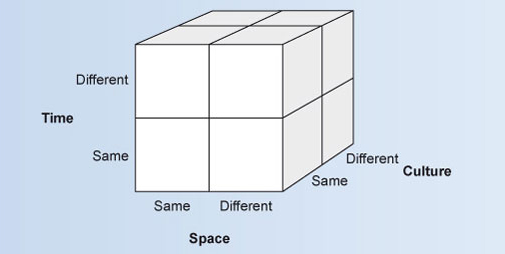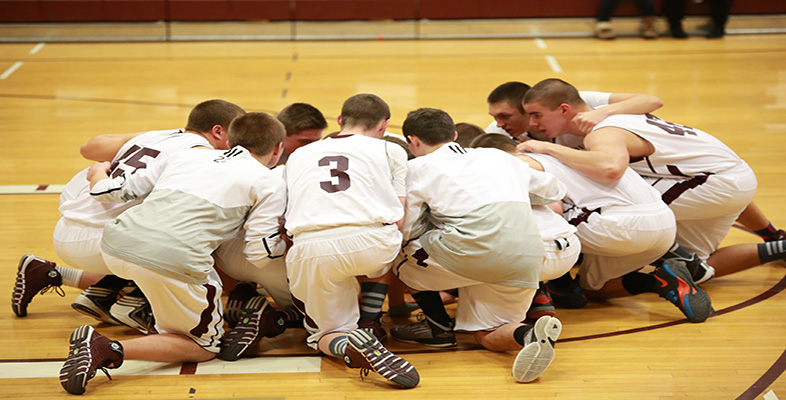2 Types of virtual team
Several ways of characterising or classifying virtual teams have been proposed in the literature. One of the most popular was elaborated by Fisher and Fisher (2001), who argued that virtual teams typically can be characterised by three variables, or dimensions. These variables are time, space and culture, although other authors also refer to the third variable as organisation. Thinking about these three variables as dimensions enables us to draw the diagram shown in Figure 2.

Understanding these three variables is useful in determining what kind of virtual team you might be involved in and in helping you decide on appropriate actions to improve them. For example, a team that has members working in the same place at different times (such as an operational team providing telephone services in a bank) might be able to meet some of their communication needs using noticeboards in their shared office space, but a team that is distributed across multiple sites or time zones would need a different communication strategy.
Time refers to when people work. Virtual team members may be assigned to work different hours, on different shifts or on different days. They may work at the same time, but be in different time zones, so the time when their working day overlaps with other team members is short.
Space (or place) refers to where people work. Virtual team workers may work close to one another or at a distance. They may share the same office or work in different places in the same building. They may work in different buildings, in different towns, or even in different countries.
Culture (or organisation) refers to who people work for and how people work together. Aspects of culture include language, race, nationality, profession, education and gender, as well as religious, political, social and economic factors.
In Figure 1, the continuum is divided into just eight boxes, to represent eight types of team, depending upon whether the time, space or culture variable is the same or different. So, for example, in the bottom left corner of the diagram you would place teams that work at the same time, in the same place, for the same organisation. In contrast, at the top right corner of the diagram are teams whose members work at different times, in different places, for different organisations.
Two of these boxes – the same time, same space, same organisation teams that we have already discussed, and the one behind it in Figure 1 (same time, same space, different organisation teams) – are not virtual teams according to Fisher and Fisher (2001). You may disagree with this viewpoint, but a team consisting of people working for different organisations (or cultures) but who work at the same place and at the same time may not need technology to mediate their interactions, although they may prefer to operate virtually. They should be able to meet in the same room even if they need interpreters or other intermediaries to facilitate their interactions.
Activity 2
To help you think about the different types of team and the implications of the three variables for teams of different types, we have partially completed Table 3 with examples of virtual teams and the potential challenges that are implicit in these variables. We have put an example team and a team challenge in each row, but some examples and challenges can be placed in more than one row. Identify them. There are other examples and challenges that do not appear in the table. Identify some of them.
| Type | Time | Space | Culture | Example | Challenges |
|---|---|---|---|---|---|
| 1 | Different | Same | Different | Customer service team | Interaction between organisations or cultures |
| 2 | Different | Different | Different | Global team | |
| 3 | Same | Different | Different | Regional services | |
| 4 | Different | Same | Same | Warehouse team | Interaction between shifts |
| 5 | Different | Different | Same | Multinational organisation | |
| 6 | Same | Different | Same | OU Regional Centres | Interaction at a distance |
| 7 | Same | Same | Same | Project team | Not a virtual team |
| 8 | Same | Same | Different | Contract team | Not a virtual team |
Discussion
Type 1 and Type 4 teams differ in whether or not team members come from the same (Type 4) or different (Type 1) organisations or cultures. Both types of team are typical of customer service, manufacturing or warehouse teams that have multiple shifts of people using the same space to provide the same service or function, but working at different times. In practice, these two types of team can use non-technical means to communicate with each other, such as leaving notes or writing on shared noticeboards. Many teams in this situation use overlapping shifts to provide face-to-face meetings and facilitate shift handovers.
A typical Type 2 team could be an international product development team, a multinational organisation or a global project team. Again, Type 2 teams are similar to Type 5 teams, differing only in whether team members work for the same organisation or have similar cultural backgrounds. In a world that is becoming increasingly globalised, teams of this type are becoming increasingly common. For example, in order to speed product development and reduce time to market, teams are being formed with members that are located in countries distributed roughly eight hours apart around the globe. At the end of the working day in one location, the work in progress is handed on to team members who are just beginning their working day, eight or so hours behind them. Teams of these types are the most difficult to manage and work in because they cross time and space, and potentially organisation. Team members must become proficient in using asynchronous technologies such as email or shared workspaces. Since times when synchronous communication by audio or video conferencing can take place will be limited, such meetings that do take place by these means must be used very efficiently.
Many virtual teams are of Types 3 or 5, consisting of people who work at different locations but for the same (Type 5) or different (Type 3) organisations. These could be regional sales teams or teams providing other regional services. Such teams have the benefit of working at the same time so they can work remotely, in real time, using synchronous technologies. Face-to-face interaction is difficult since the team members are normally working at different locations, so they will have to travel to meet in the same place.
Finally, Type 7 and Type 8 teams are included in the table for completeness. These are not virtual teams. From your own or others’ experiences, you might like to add further examples, or note down team challenges typical of conventional teams.
Author’s reflection
Taking some examples from my own experience: I work with colleagues at the Open University, based both at Walton Hall and the Regional Centres, on a variety of projects in different teams. These are examples of Type 5 teams when they involve colleagues from centres other than the one where I work. If everyone is based at the same location then they should really consider themselves to be a Type 7 team – same time, same space (or place), same organisation – but email is so pervasive that people can use that rather than the telephone or a quick face-to-face conversation.
I also work on a research project with colleagues at the Natural History Museum, London. This is an example of a Type 3 team since we work for different organisations, at a distance, but in the same time zone. On another research project, colleagues in Japan are involved, so this is an example of a Type 2 team. Time zone differences make it difficult to schedule audio or video conferences, but we have used it to our advantage when trying to meet deadlines. I can write a draft of a paper, circulate it to the team by the end of my working day and receive comments on the draft from my Japanese colleagues in time for the beginning of my next working day. It is exhausting, since you don’t get a break from working on the paper, but the work is finished quickly!
